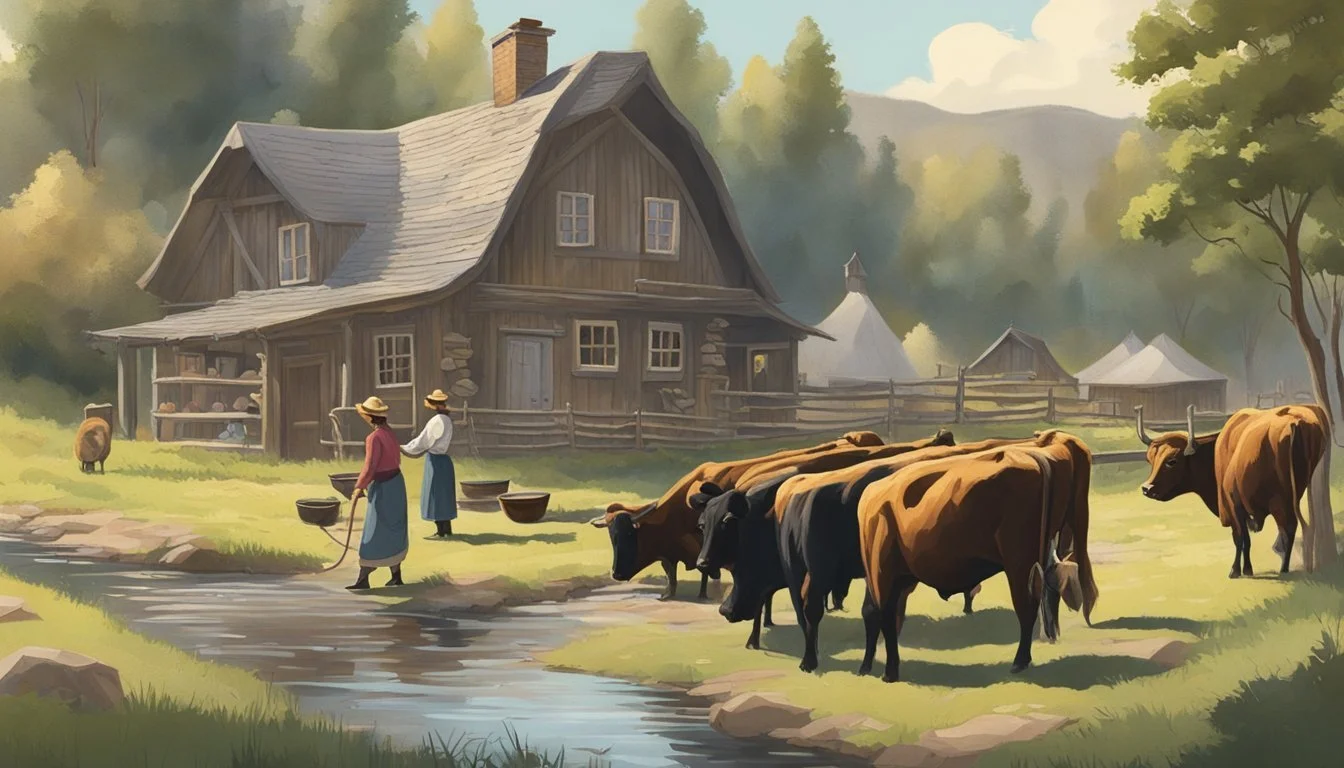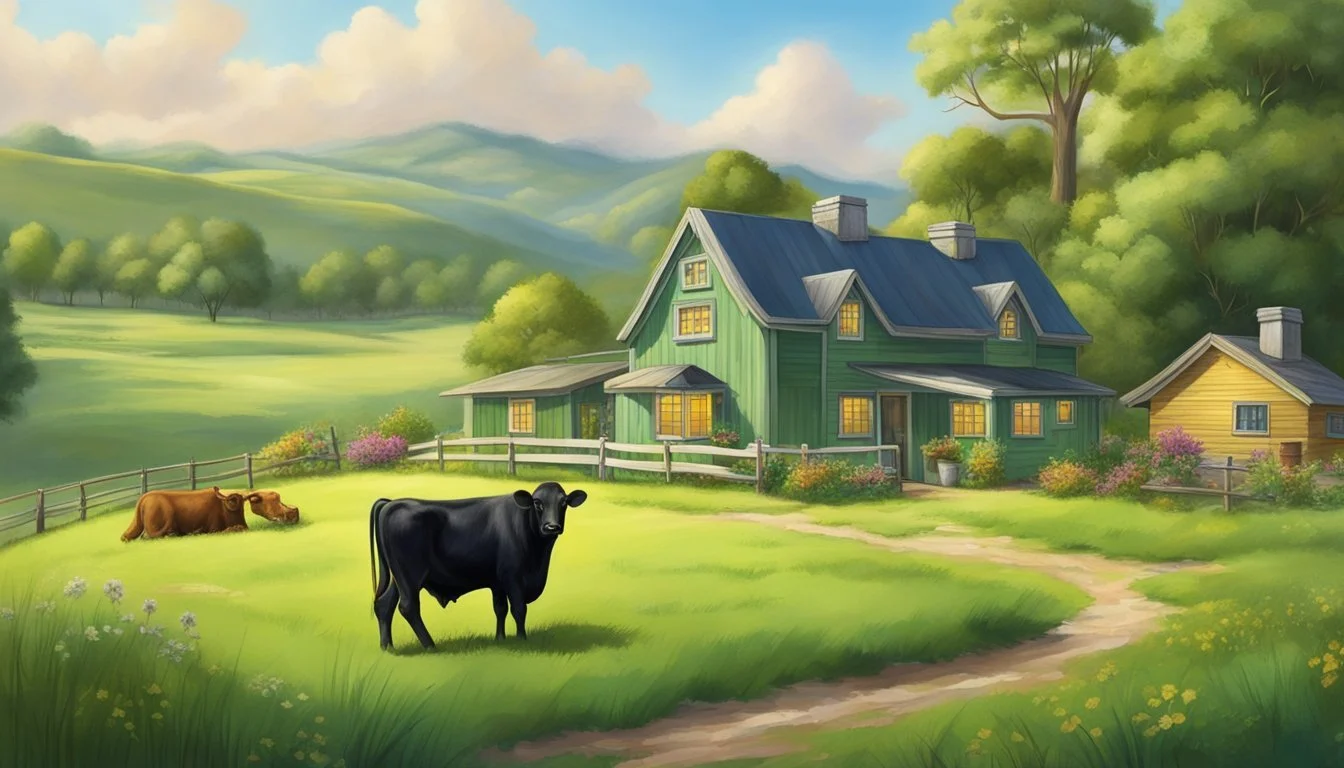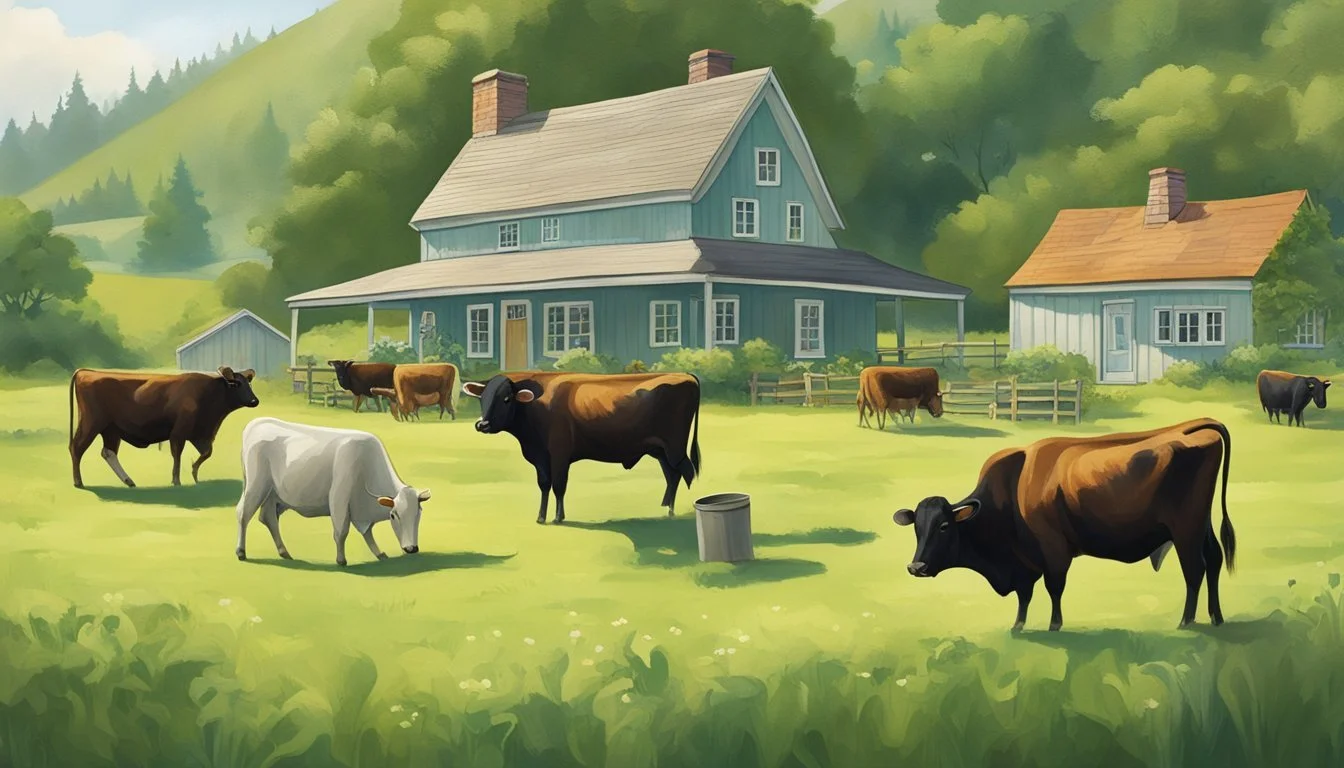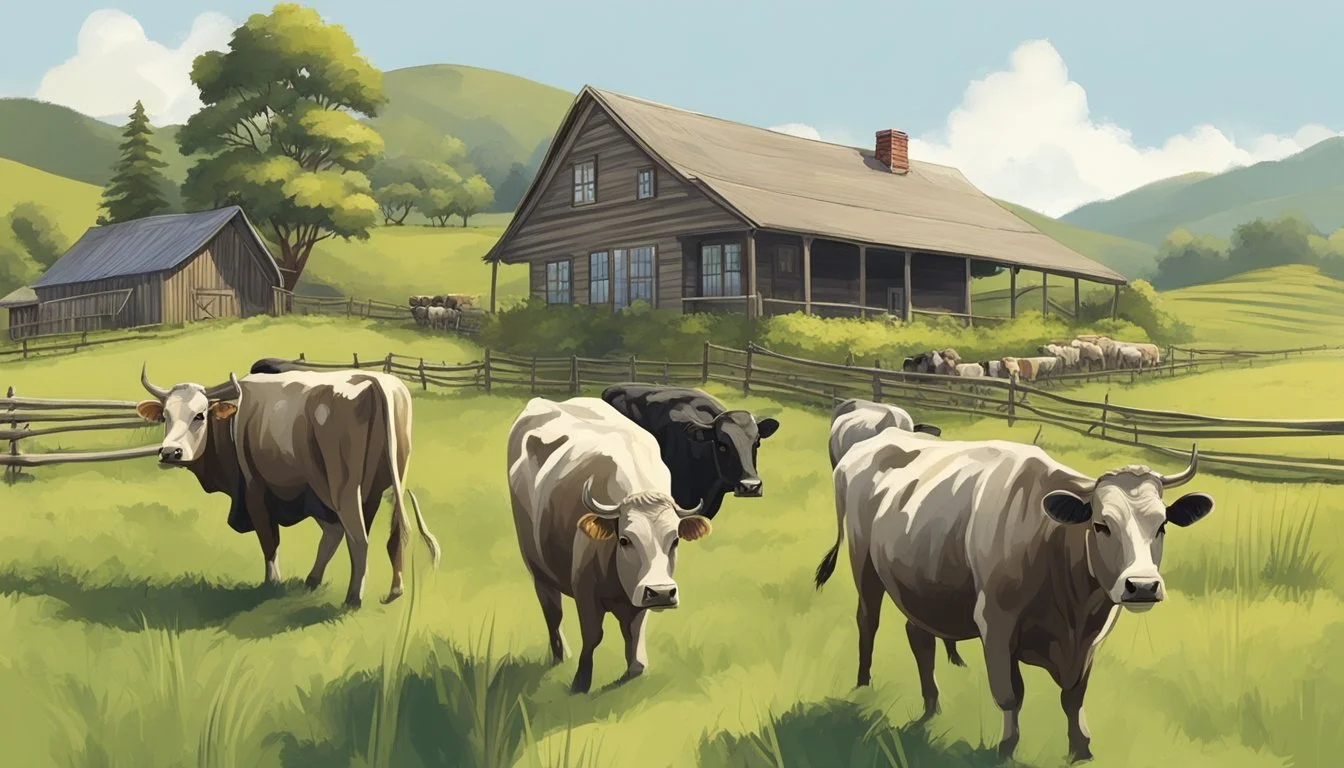Dexter Cattle and the Cottage Industry
Exploring Diverse Homemade Goods
Dexter cattle have garnered a reputation not just for their agricultural value but also for their role in augmenting cottage industries. These small, hardy bovines, recognizable by their less fibrous and finely grained beef, are also prized for their quality milk production. Originally hailing from Ireland, their compact size and versatility have made them a favored choice for small-scale farms, where they effectively convert grass into nutritious food, which forms the basis of a variety of dairy and meat products.
Moving beyond the traditional realm of food, the diverse utility of Dexter cattle is showcased through an array of goods that cater to niche markets. The cottage industry has embraced this breed for the production of artisanal soaps that capitalize on the rich qualities of Dexter milk, renowned for its superior fat content. The same dairy is often the base for small-batch cheeses, bringing unique local flavors to the fore.
In addition to their contributions to dairy and meat products, the Dexter cattle's fiber is another extension of their utility. The cattle's hide and hair find use in crafting durable textiles and goods, which appeals to consumers attracted to sustainable and locally-sourced materials. These attributes underline the Dexter breed's significance in the burgeoning cottage industry, providing resources for both traditional and inventive applications.
Origins and History of Dexter Cattle
Dexter cattle are a distinct breed with a rich history rooted in Ireland and a notable impact on agriculture in various parts of the world, including the United States.
Background and Development of the Breed
The Dexter breed has its origins in the early 1800s in the southern part of Ireland, particularly in County Tipperary and County Kerry. These small-sized cattle were developed by local farmers with limited land, who needed versatile animals for both dairy and meat production. The breed appears to be named after a man named Dexter, who was an agent of Lord Hawarden, associated with Valentia Island. Not long after its development, the Dexter became recognized as a separate breed from the more common Kerry cattle.
In England in 1924, the commitment to this breed intensified when the English Kerry and Dexter Cattle Society altered its focus to concentrate solely on Dexter cattle, renaming itself the Dexter Cattle Society. This shift underscored the breed's rising distinctiveness and its growing popularity among cattle enthusiasts.
Spread to America and the Dexter's Global Presence
Dexter cattle were introduced to America in the early 1900s, quickly finding favor among small landowners and farmers who appreciated the breed's hardiness and dual-purpose characteristics. They were adaptable and capable of thriving on smaller parcels of land, making them a suitable option for diversified farming and village industries.
In the United States, the breed's registry and promotion were spearheaded by organizations such as the American Dexter Cattle Association, established to maintain breed standards and encourage breeding practices that would retain the distinctive traits of Dexter cattle. Today, Dexter cattle can be found in many countries across the globe, fulfilling roles ranging from traditional farming to innovative cottage industries.
Characteristics and Traits of Dexter Cattle
Dexter Cattle are a distinct breed valued for their versatility and adaptability, with particular attributes suited for cottage industries. They excel in milk and meat production and provide raw materials for various products like soap and fiber goods.
Physical Appearance and Conformation
Dexter Cattle are notable for their small stature and robust conformation. Adult Dexters are about half the size of traditional Hereford cattle, typically standing at a shoulder height of roughly 36 to 44 inches. Their physical appearance can be categorized based on their coat colors: predominantly black, but also available in red and dun shades. The cattle may be polled - naturally without horns - or horned, depending on their lineage.
Color: Predominantly black, with red and dun variations.
Height: Approximately 36 to 44 inches at the shoulder.
Conformation: Broad bodies with well-rounded hindquarters.
Behavioral Attributes and Temperament
Dexter Cattle are reputed for their gentle and docile temperament, making them suitable for various farming scenarios, including small-scale operations. They are known to be highly intelligent and easily handled, which contributes to their popularity among smallholders. Their calm demeanor is not only beneficial for those working with them but also speaks to their adaptability in diverse environments.
Temperament: Gentle and docile, ideal for small-scale farming.
Genetic Health Considerations
Concerning genetic health, Dexter Cattle can carry a gene for chondrodysplasia, a form of dwarfism which can affect their leg length, categorized as short-legged Dexters. It’s important for breeders to be aware of and manage this aspect to maintain the breed’s health and viability. Thankfully, due to their small breed size, they often encounter fewer calving difficulties compared to larger breeds.
Chondrodysplasia: Genetic condition that can lead to dwarfism and shorter legs.
Health Management: Breeders monitor genetic conditions to ensure the breed’s viability.
Dexter Cattle in Agriculture
In the realm of agriculture, Dexter cattle stand out due to their efficiency as a dual-purpose breed optimal for both meat and dairy production on a small-scale. They exemplify sustainable farming practices by thriving on less acreage while providing quality beef and high butterfat milk.
As a Dual-Purpose Breed
Dexter cattle exhibit an innate versatility being a dual-purpose breed, adept for both meat and dairy production. The lean, quality beef they yield is complemented by their capacity for milk production with an impressively high butterfat content, a combination that is relatively rare in other breeds. This duality not only maximizes the use of each animal but also offers variety and sustainability to farmers, particularly those handling smaller herds.
Grass-Fed Beef and Dairy Production
Dexter cattle are efficient in converting grass to both meat and milk, which allows them to be raised effectively on pasture-based systems. With their grass-fed beef being lean and rich in flavor, Dexters are a popular choice for those looking for healthier meat options. On the dairy side, their milk is known for its high butterfat content, producing creamy milk that is well-suited for cheese and butter production. The efficient use of acreage for grazing not only maintains the health of the cattle but also contributes to the sustainability of the farm's ecosystem.
Dexter Cattle for Small-scale Farming
Specifically beneficial for small-scale farming, Dexter cattle require less acreage due to their smaller size compared to other breeds. Their adaptability and gentle disposition make them an ideal candidate for diversified farm operations. Breeding Dexter cattle can be advantageous as they tend to have long reproductive lifespans and range in color and patterns, which can contribute to niche marketing for small farm businesses. The cattle's manageable size and efficient milk and meat production mean smaller farms can deliver quality products without the extensive resources larger cattle breeds might demand.
Dexter Cattle Management and Husbandry
Successful management and husbandry of Dexter cattle are fundamental to ensuring their productivity and welfare. This entails a focus on specific feeding regimens, regular healthcare, and accurate breeding techniques.
Feeding and Nutrition Requirements
Dexter cattle require a balanced diet that involves a mix of forages and grains to provide the necessary energy and nutrients. They generally thrive on:
Grasses: Timothy, Bermuda, and other local varieties suitable for the region.
Legumes: Alfalfa and clover can supplement the protein needs of the herd.
Concentrates: A mix of grains to boost energy, especially during lactation or growth periods.
Feeding Table:
Life Stage: Calves (weaning)
Feed Type: High Protein Pellets
Quantity: 1-2 pounds/day
Life Stage: Heifers/Cows (growth)
Feed Type: Mixed Hay & Grains
Quantity: 2-3% of body weight/day
Life Stage: Bulls
Feed Type: Maintenance Feed
Quantity: 2-2.5% of body weight/day
Life Stage: Pregnant/Nursing Cows
Feed Type: High-quality Forage & Grain
Quantity: Increase by 10-15%Healthcare and Veterinary Needs
Regular check-ups from a veterinarian are imperative to maintain the health of a Dexter herd. Key healthcare practices include:
Vaccinations: To prevent common bovine diseases.
Parasite Control: Routine deworming and external parasite management.
Hoof Care: Regular trimming to prevent foot issues.
Calving: Monitor cows for calving difficulties, assisting when necessary.
Healthcare Checklist:
Annual vaccinations
Biannual parasite treatments
Monthly hoof inspections
Breeding and Herd Maintenance
Breeding Dexter cattle requires attention to their fertility rate and observation for productive pairing. Herd maintenance involves:
Selection: Choose cows and bulls with desirable traits to maintain herd quality.
Record-Keeping: Accurate records of breeding, birth, and health data.
Calving: Support cows during calving if complications arise.
Fertility is monitored, with the goal to achieve:
High fertility rate for cows.
Optimal conditions for bulls to ensure successful breeding.
By adhering to these management and husbandry practices, farmers can ensure that their Dexter cattle herds are healthy, productive, and well-suited for cottage industry applications.
Sustainability and Environmental Impact
Dexter cattle offer a compact and efficient alternative for small landholders looking to maintain sustainable agricultural practices. Their characteristics cater to concerns about environmental footprints and the responsible management of land resources.
Adaptation to Various Climatic Conditions
Dexter cattle are recognized for their hardiness and adaptation to a range of climatic conditions. They can thrive in varying temperatures and environments, which reduces the need for energy-intensive housing and maintenance. This adaptability makes them well-suited for small landholders who might face diverse weather patterns. The breed's efficient nature means they require less feed compared to larger cattle breeds, exerting less damage on pastures and feed resources.
Climatic resilience:
Able to withstand hot and cold weather without extra energy costs.
Increased survival rates in diverse environments.
Feed efficiency:
They gain adequate nourishment from lower quantities of feed.
Their diet can include a mix of grass and less competitive food sources.
Contribution to Biodiversity and Land Management
Dexter cattle contribute positively to biodiversity and land management. Their grazing patterns often prevent overgrowth and promote the health of grassland ecosystems. This grazing efficiency can help maintain the land's natural biodiversity, supporting various plant and animal species. Additionally, their ease of handling allows landowners to manage herds effectively, ensuring that their impact on the land is controlled and conducive to long-term sustainability.
Biodiversity preservation:
Grazing habits that sustain different plant species.
Low-stress impact on the land helps protect soil quality.
Land management benefits:
Small size and temperate makes them easier for farmers to manage.
Encourages sustainable practices among small-scale producers.
Cottage Industry and Craft Uses of Dexter Cattle
Dexter cattle contribute to the cottage industry with their diverse products ranging from rich dairy for cheese-making to tallow for soap production and even their fiber for crafting.
From Milk to Artisan Cheese Production
Dexter cows produce a moderate amount of milk high in butterfat, typically 4%-5%. This rich milk is ideal for creating artisan cheese, valued for its creamy texture and depth of flavor. Small-scale cheesemakers appreciate the milk from Dexter cattle for its high quality and the distinct characteristics it imparts to specialty cheeses.
Sustainable Soap Making with Beef Tallow
The beef tallow from Dexter cattle, a byproduct of meat processing, is a sustainable resource for soap making. Tallow-based soaps are noted for their creaminess and moisturizing properties. Cottage industries utilize this tallow to craft handmade soaps, often incorporating natural ingredients and essential oils to produce a variety of cleansing products.
Fiber Products from Dexter Cattle
Though primarily known for beef and milk, Dexter cattle can also produce fiber from their hides. The fiber, processed into yarn, can be used in various craft applications such as knitting or weaving, and it presents hobbyists and small businesses with an additional product to offer within the niche market of natural and locally-sourced craft materials.
Dexter Cattle Organizations and Conservation Efforts
Dexter cattle breed societies and associations play a crucial role in the conservation and preservation of this unique breed. They ensure the breed's purity, promote its values, and prioritize sustainable practices for its growth.
The Role of Breed Societies and Associations
The American Dexter Cattle Association (ADCA) and Dexter Cattle Society are pivotal in maintaining the Dexter breed's status and enthusiasm among breeders. These organizations offer a wealth of information and support to Dexter cattle owners, including:
Pedigree Search: Helping maintain the genetic diversity and health of the breed.
Breed Standards: Establishing and confirming the qualities that make Dexter cattle unique.
Membership Services: Providing a community for breeders and enthusiasts to share knowledge and practices for effective breeding and management.
They are also involved in promoting the Dexter cattle as a versatile breed, ideal for small-scale farming due to their dual-purpose nature for both meat and milk production.
Policies for Registration and Breed Preservation
To preserve the breed's integrity, associations implement strict registration policies. These include:
Defining acceptable characteristics and traceability requirements.
Recording lineages to ensure the purity of the breed.
Encouraging conservation practices to maintain the population.
By adhering to these policies, the ADCA and Dexter Cattle Society contribute significantly to the conservation efforts for rare breeds. Dexter cattle, once at risk, are now being preserved and promoted as a valuable resource for cottage industries, thanks to the diligent work of these organizations. The associations ensure that Dexters remain a part of our agricultural heritage and continue to benefit small farms with their diverse applications from soap to fiber products.
Future Trends in Rearing Dexter Cattle
Within the evolving landscape of agriculture, Dexter cattle are earning a distinct place. They offer an enticing combination of efficiency and adaptability for small-scale farmers, fitting well into the growing niche for sustainable livestock management.
Innovations in Small-scale Farming with Dexters
Small-scale farming with Dexter cattle is seeing a wave of innovation. As the smallest European breed of cattle, Dexters take up less space and consume fewer resources, making them an efficient choice for farmers with limited land. Precision agriculture technologies and data analytics are being integrated into Dexter farming practices to optimize feed efficiency and track cattle health, thus maximizing the productivity of these dual-purpose (meat and milk) animals. Farmers are adopting seasonally adaptive grazing methods which allow them to maintain the health and weight of their livestock while preserving the environment.
Growing Demand for Sustainable Livestock
There is a clear upward trend in consumer demand for sustainable livestock products. Dexter cattle, known for their hardiness and lower environmental footprint, offer a compelling solution for farmers looking to meet this demand. Their small size and dual-purpose utility encourage sustainable practices such as rotational grazing, which improves pasture longevity and reduces the need for chemical fertilizers. These practices, in turn, lower the carbon footprint of farms and make Dexters a key player in the market for ecologically conscious consumers. As the market for local and sustainable goods expands, so does the potential for Dexter cattle to play a larger role in the eco-friendly agricultural economy.
Appendix
This section of the article provides definitions for key terms discussed throughout and offers a curated list of materials for those seeking deeper insights into Dexter Cattle and cottage industries.
Glossary of Terms
Dexter Cattle: A small, dual-purpose breed of cattle originating from Ireland, known for their beef and milk production.
Cottage Industry: Small-scale, decentralized production often operated out of homes utilizing craft or artisanal methods.
Felting: A process used to create a dense fabric by matting, condensing, and pressing fibers together.
Tallow: Rendered fat from cattle, commonly used in the manufacturing of soap.
Raw Milk: Unpasteurized milk directly from cattle, which can be crafted into dairy products such as cheese.
Handspun Yarn: Yarn that is spun by hand from animal fibers including the wool of Dexter Cattle, often used in knitting or weaving.
Artisanal Cheese: Specialty cheeses crafted in a traditional manner, often with milk from breeds like Dexter Cattle.
Further Reading and Resources
Books:
"The Dexter Cattle Handbook" by D. Phillip Sponenberg
"Handmade Soap Book" by Melinda Coss
Websites:
American Dexter Cattle Association – Provides extensive resources on breeding, care, and history.
The International Feltmakers Association – Offers tutorials and techniques on felting.
Organizations:
The Handweavers Guild of America, Inc. – Supports fiber artists with resources for spinning and weaving.
The American Cheese Society – Focuses on promoting and supporting artisanal cheese production.










